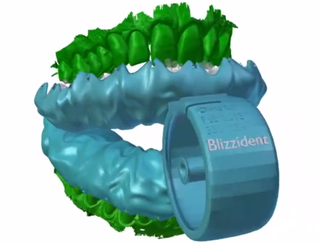3D Printed Toothbrush Tailored to Your Teeth

Forget electric toothbrushes — using 3D printing, engineers have developed a new kind of toothbrush tailor-made to fit a person's mouth. All a person must do to brush is bite down.
At first glance, the "Blizzident" looks a bit like a hairy pair of dentures. The brush's makers say it cleans teeth completely within six seconds, though independent studies have not yet verified its efficacy.
To tailor the brush to a person's mouth, dentists take a digital scan of the teeth (or take an impression that is later scanned). The makers of Blizzident use that scan to determine the optimal placement of 600 bristles by simulating biting and chewing movements. The bristles resemble normal toothbrush bristles but are much finer and tapered to reach under the gumline better.
The makers use 3D printing create the brush itself. They use the dental scan to create a computer aided design (CAD) model of the brush, which is converted into a 3D object using stereolithography, a method in which liquid plastic is cured into a shape with an ultraviolet laser. The bristles are then painstakingly attached to this object. [The 10 Weirdest Things Created By 3D Printing]
To brush with the Blizzident, a person simply bites down on it and grinds his or her noshers for about six seconds. This biting motion achieves the effect of the Modified Bass technique (in which the brush is positioned at a 45-degree angle to the teeth roots and brushed back and forth), and the Fones technique (in which the brush is held at right angles to the teeth and brushed in large circles), the Blizzident makers say.
The tailor-made toothbrush, available online or from some dentists, currently costs a hefty $299. But the brush's makers stress it could actually save people money in dental costs, as well as time spent brushing their teeth.
Follow Tanya Lewis on Twitter and Google+. Follow us @livescience, Facebook & Google+. Original article on LiveScience.
Sign up for the Live Science daily newsletter now
Get the world’s most fascinating discoveries delivered straight to your inbox.

